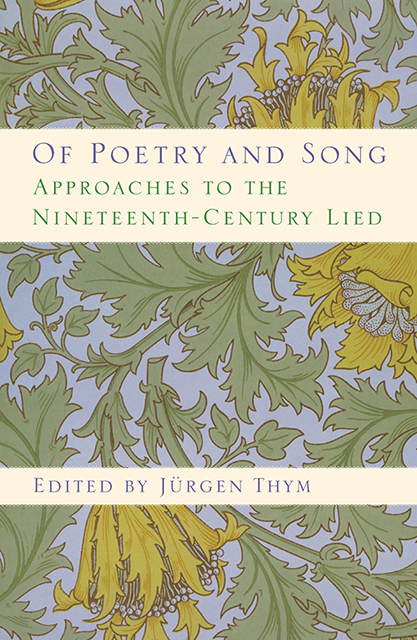Chapter Seven - Text and Music in Schubert’s Settings of Pentameter Poetry
Published online by Cambridge University Press: 02 March 2023
Summary
Song composers since the Renaissance have tended to set texts according to the speech rhythms of the poetic lines. As analysts, we often take good declamation for granted, noting only occasional faux pas of accentuation or awkward phrasing. Investigations of the relation of text to music in song address other questions of textrelated expressivity and musical coherence but seldom examine this fundamental area of text-music coordination. Our purpose in this chapter is to call attention to Schubert's mastery of declamation, specifically with regard to his settings of pentameter poetry. We hope to show that these settings, while responding to the rhythmic requirements of the texts, at the same time artfully integrate a handful of stock declamatory patterns into the musical whole and, furthermore, that these rhythms themselves may become prominent motivic and expressive features of the songs.
For the Lied composer, pentameter verse offers a special challenge. The five-foot lines are longer than those of most lyric poetry and are often metrically and syntactically more complex. Moreover, pentameter lines are less obviously compatible than are trimeter and tetrameter lines with the two-, three-, and four-bar phrase structure favored by the musical tradition. Franz Schubert frequently faced the task of setting such lines. Ninety-two of his more than six-hundred songs contain one or more pentameter lines, and twenty-seven of them are based on poems entirely in pentameter. The nearly nine-hundred pentameter lines in his Lieder therefore offer a rich source for an investigation of the musical treatment of such lines.
For our study we initially identified all lines with five accents, and from Schubert's settings of these lines we extracted two principles governing declamation as well as various recurring declamation patterns corresponding to those two principles. Next we studied the lines themselves more closely to discover what relation there might be between the declamation patterns and the internal structure of the lines. Finally, we examined a number of whole songs in detail to determine how these patterns might play out in entire compositions, giving particular attention to the formal and expressive functions of these patterns.
- Type
- Chapter
- Information
- Of Poetry and SongApproaches to the Nineteenth-Century Lied, pp. 155 - 219Publisher: Boydell & BrewerPrint publication year: 2010
Accessibility information
- 3
- Cited by

